I may or may not have had Covid about two weeks ago.
At the time, I knew I had come down with something. I largely lost my voice and spent about a week carefully conserving what remained. I spent over a week coughing a decent amount. I was having some trouble breathing when any pressure was applied to my chest and occasionally at other times.
I never felt the situation was that serious and thought it probably wasn’t Covid, and never got tested or took any treatment beyond the normal resting and staying home for a minor illness plus resting my voice, expecting it to get better. Which it did.
My personal trainer, however, immediately assumed that of course it was Covid. It certainly is possible. In the end, it does not much matter. I presume I will never know for sure.
I am fully recovered now, except that I lost some progress exercising, especially on the elliptical machine, and am still working to get back to where I was before, which I anticipate will take another week or two.
This is permanent normal. We get sick. We don’t know exactly what it was. Over time, we mostly feel better. There is not much Covid news, so it seems fine to have the introduction be a personal tale like this.
That also, combined with doing some longer term work on various things, is why I haven’t been putting out any additional content beyond the weekly posts for a bit. That will change. I also am considering how much I should be ‘spinning off’ various things into their own posts.
Executive Summary
- Covalent boosters now available wherever vaccines are administered.
- Covid cases dropped unexpectedly.
- The dog that didn’t bark: Zero monkeypox news of note.
Let’s run the numbers.
The Numbers
Predictions
Prediction from last week: 490k cases (+9%) and 3,000 deaths (+10%)
Results: 389k cases (-14%) and 2,878 deaths (+5%).
Prediction for next week: 350k cases (-10%) and 2,625 deaths (-9%).
California normally reports cases twice a week and this week only reported once. I am going to assume this is a delay and conservatively added 20,000 additional cases and 70 additional deaths. These will be subtracted from next week’s numbers, unless I discover something weird going on that makes me do something else instead. Deaths are typically jumpy, so only making the adjustment there because of the very obvious need to adjust cases. Not going to worry too much about it all given the low value of information.
I cannot think of a reason for general lack of reporting last week, and California has been adjusted. This reduction is on top of coming back from Labor Day weekend, so I am going to assume it is a real drop, and expect it to continue faster than expected. Deaths should also be steadily falling.
Deaths

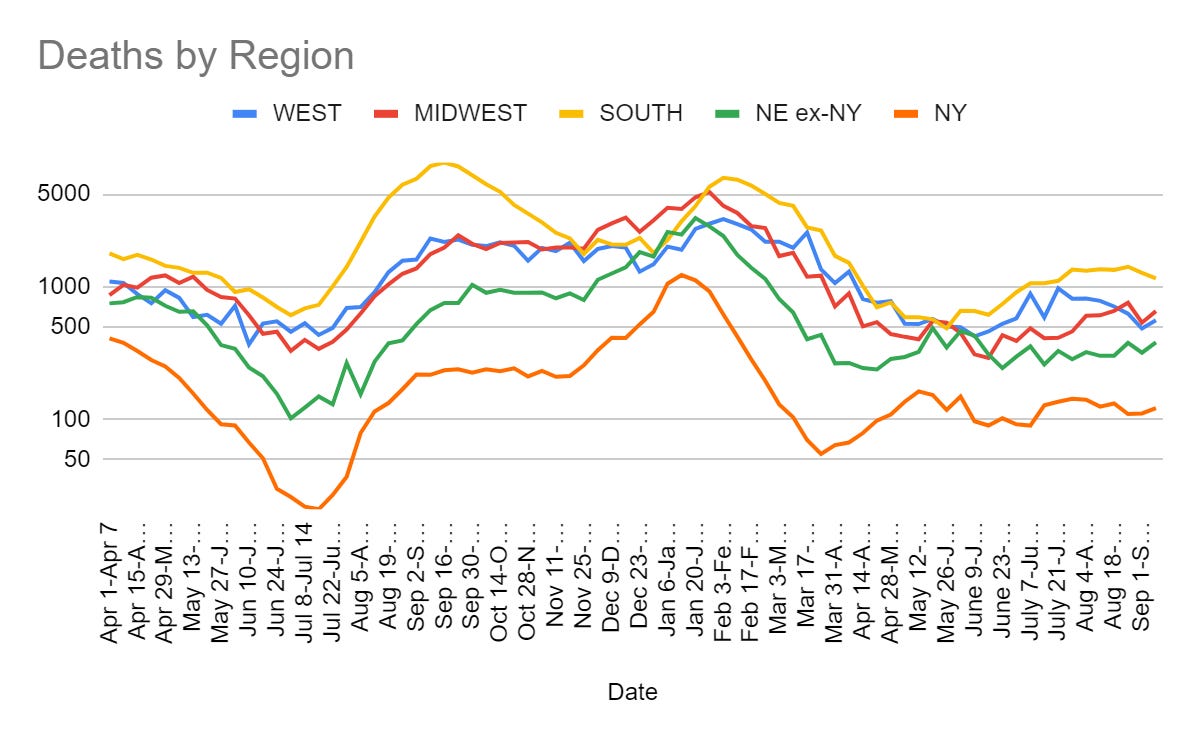
Cases

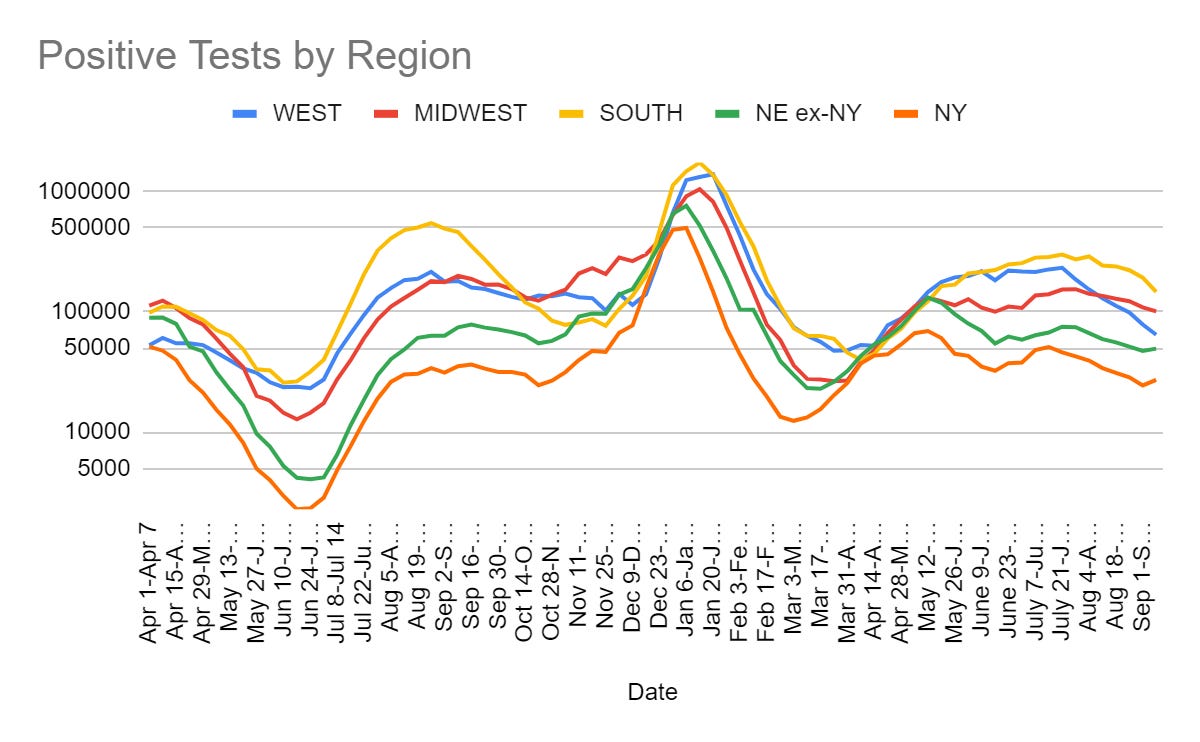
Physical World Modeling
Bloom Labs thread about origins of Omicron. Makes a strong case.

Bloom Lab reports that mouse tests show updated vaccines work better against BA.5.
New Long Covid research initiative, currently has $15 million in funding and looking to get to $100 million, with a focus on exploring treatments. There is shade thrown towards RECOVER, saying it is being slow to recruit patients, and also the implication it won’t be taking enough active steps, and so a smaller but less risk averse effort is needed and can do better. This seems likely to me. Post includes CDC estimate that 40% or more of Americans have had Covid, which seems quite low.
Thread and Atlantic article on brain fog. To extent people do have brain fog it is indeed a major drag on ability to live life and be productive. Doesn’t update me on how often this is caused by Covid.
South African results find vaccination surprisingly ineffective and fast to fade. (Study)
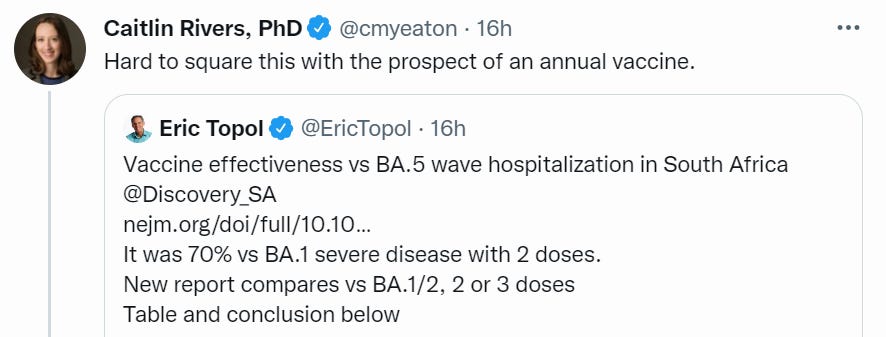
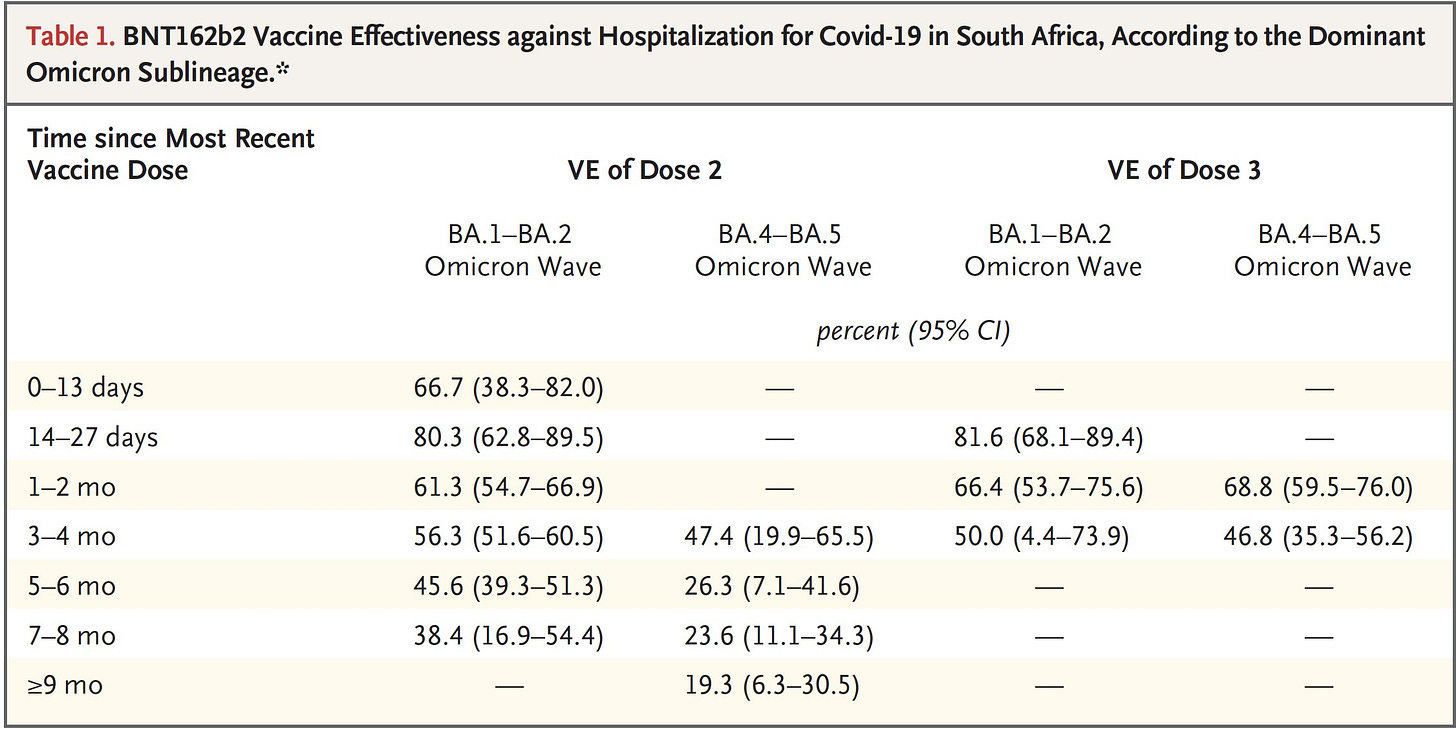

These numbers are against severe disease not infection.
Whenever I see someone saying a study is hard to square with a public health decision, I inevitably think ‘oh, oh, pick me, pick me!’
There are at least four distinct ways to reconcile these two things.
- The study is almost certainly very wrong. It could be technically correct while not applying elsewhere due to massive infection rates during prior waves. It could also have various selection effects invalidating the results. We have (1) other results about vaccine effectiveness, (2) Omicron continuing to be mostly controlled after initial infections, (3) Omicron being as mild as it was, (4) Omicron statistics elsewhere in the world on severe disease despite most vaccinations having been reasonably old by then, (5) Omicron stabilizing at a relatively low rate with essentially zero precautions.
- The study specifically points to a mismatched booster. We won’t always have a good match but we are covalent now which helps and we will eventually update again if we need to do that.
- The annual booster is not meant to prevent Covid or to prevent severe disease from Covid. The annual booster is a compromise between ‘people will not accept more frequent boosters but might accept annual ones’ and demands to endlessly Do More on all fronts and give people a way to stay Up To Date and Responsible. It is a symbolic act. Annual flu shots make sense because we can update them in time to get to the right formula before infection, with Covid we cannot do this, yet Public Health gonna Public Health.
- Not distinct from (2) but a different angle: The annual booster is not real. Most people will not be getting it. Uptake even on the first booster was not so high. Uptake on the second booster is dreadfully low. Again, we are not attempting to update it in time to matter. Thus, we can reconcile it with the second booster by noticing that the second booster is a phantom. It is a way to urge people to Do More and to blame those who don’t do it, and little else outside of those who are especially vulnerable because they are elderly or immunocompromised.
- The annual booster can still work if it is based on the presumption that Covid will take place in month-in-advance-predictable waves. There is a distinct ‘flu season’ and thus we are told to delay vaccination for flu if possible to get maximum effect. If Covid proves sufficiently seasonal, getting a short right before a predictable winter surge is still a reasonable choice. Alternatively, surges going forward can be caused by new variants, which again will give us enough warning to pivot into getting boosters when we hear the news, for a on-the-ball subset of the full we.
Booster Boosting
None of the above explanations make it unreasonable to get boosted. I continue to think it is a good idea to get boosted once if you haven’t been yet, and that it is reasonable to get boosted again periodically.
Chise thread saying get boosted as soon as possible. No new info but covers basics.
Celine Gounder continues to recommend new booster for the immunocompromised and those over 50.
Zeynep thinks the new boosters will be effective.
Predictions of Permanent Midnight
What is the right way to think about the following? (link to memo quoted by Echo Chamber)
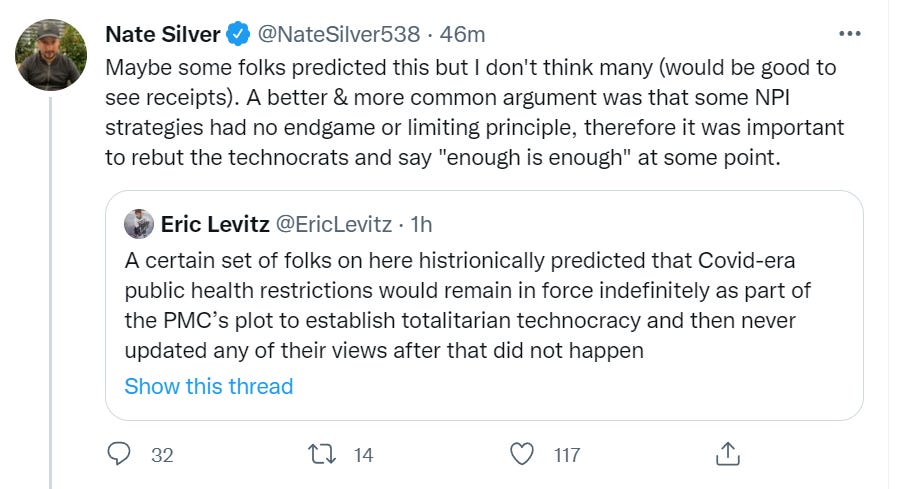


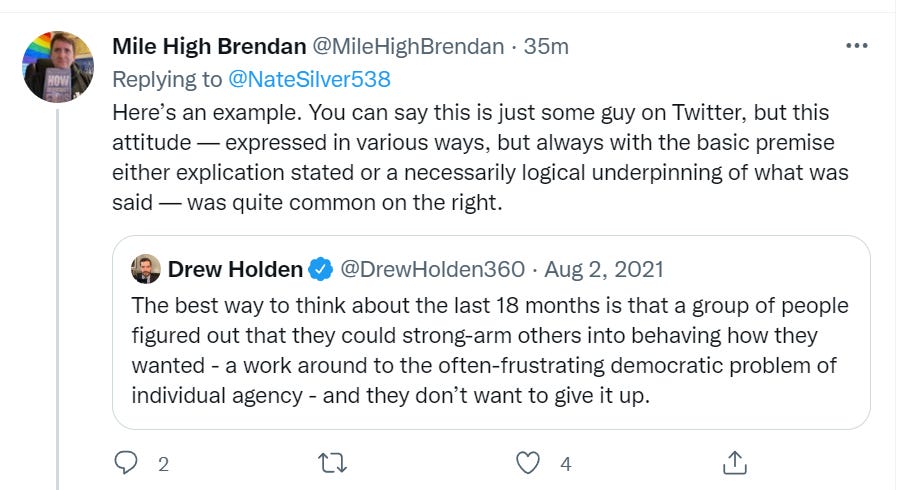

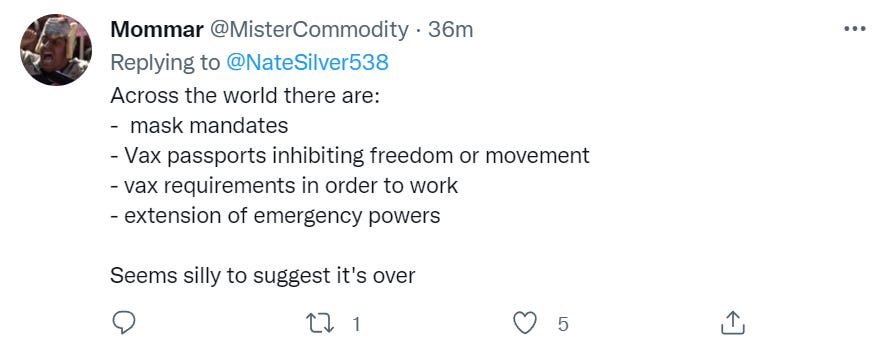
My interpretation is that there was a fight between those who want Permanent Midnight and those who wanted to move on with our lives.
In America, the Permanent Midnight advocates mostly lost, with notable important exceptions that include the forced masking of millions of young children.
Some of that is bureaucratic inertia.
Some of it is not. As an example, here is parent proud of the damage inflicted upon their child, as child ‘updates’ a poster’s claim of what will matter thirty years from now from ‘what I have learned’ to ‘how well my mask was sealed.’

Before, inspiring a love of learning:

After, in Permanent Midnight:

Imagine being proud about this substitution. What that implies.
Such people have given up. They fight on. Last week, I mentioned that disability advocates in NYC were in this camp:
New York City lifts its mask mandates for mass transit, only months after everyone finished learning to ignore them. Disabled advocacy group expresses its dismay, instead advocating for Permanent Midnight because someone, somewhere is immunocompromised. Also complains that someone, somewhere has worn a mask improperly and implicitly demands the government fix this.
A commentor fully endorsed their position, and accused me of ‘punching down.’
If the cost of making things safer for the disabled is that people have to wear masks on the subway, that’s a bargain. Conversely, if the cost of riding the subway mask-free is that disabled people have to indefinitely continue to isolate themselves from the outside world so that they don’t get sick and die, then they’re getting ripped off, and they’re right to be mad about it.
There are better ways to address criticism you disagree with than to punch down on the disabled and the immunocompromised.
So, yes. There are definitely people who 100% seriously advocate Permanent Midnight. I believe that if those people got their way, a majority of them would label any opposition to their position as harmful misinformation and ask it to be censored. Earlier in the pandemic, they often got their way on that. Fortunately, they mostly lost.
As a cautionary tale, in China they continue to maintain a zero-Covid policy. Everyone lives, to this day, under constant threat of a new lockdown.
I consider the sane versions of the expectation of Permanent Midnight to have been a self-defeating prophecy. The reason why we don’t live under this regime is that a lot of people were determined to fight against it.
Those people should absolutely update. They expected something, then it did not happen.
What about those people who said this would never happen? That such requirements would be withdrawn when they were no longer necessary, or at least reasonably soon afterwards?
Those people should absolutely update, as well. They expected something, it did mostly happen, but they were almost all vastly overconfident. That isn’t right, either.
The only ones who get full credit are people who were moderately more worried about such outcomes than I was. I was too dismissive of the magnitude of these risks. I did not factor in these risks enough into my evaluations of at-the-time worthwhile interventions. Thus, I am updating towards taking similar risks more seriously in the future, and giving that consideration more weight when deciding what to do.
I do not believe there was any kind of explicit conspiracy or grand plan. My model says there is hardly ever an explicit conspiracy or grand plan. Those who do such things are part of the Implicit Coalition. They lack the required social technology.
Are We All Right?
I saw a startling claim and a generous offer, and decided to do a poll to compare.

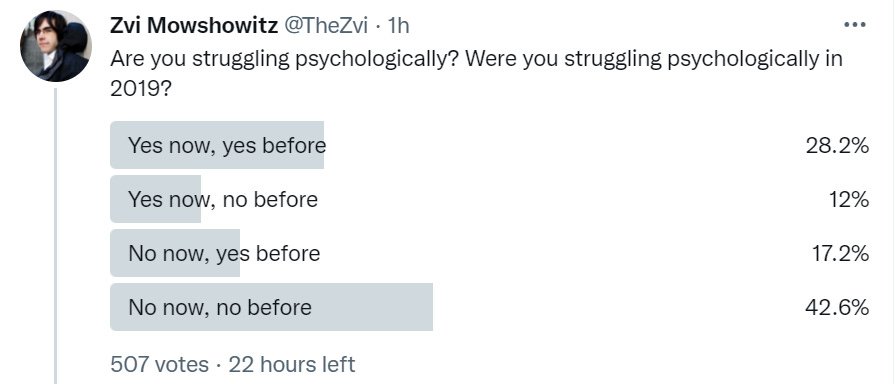
My poll results say that things are if anything marginally better, with most people back to where they were pre-pandemic. Contrast with this poll by Patrick Collison:
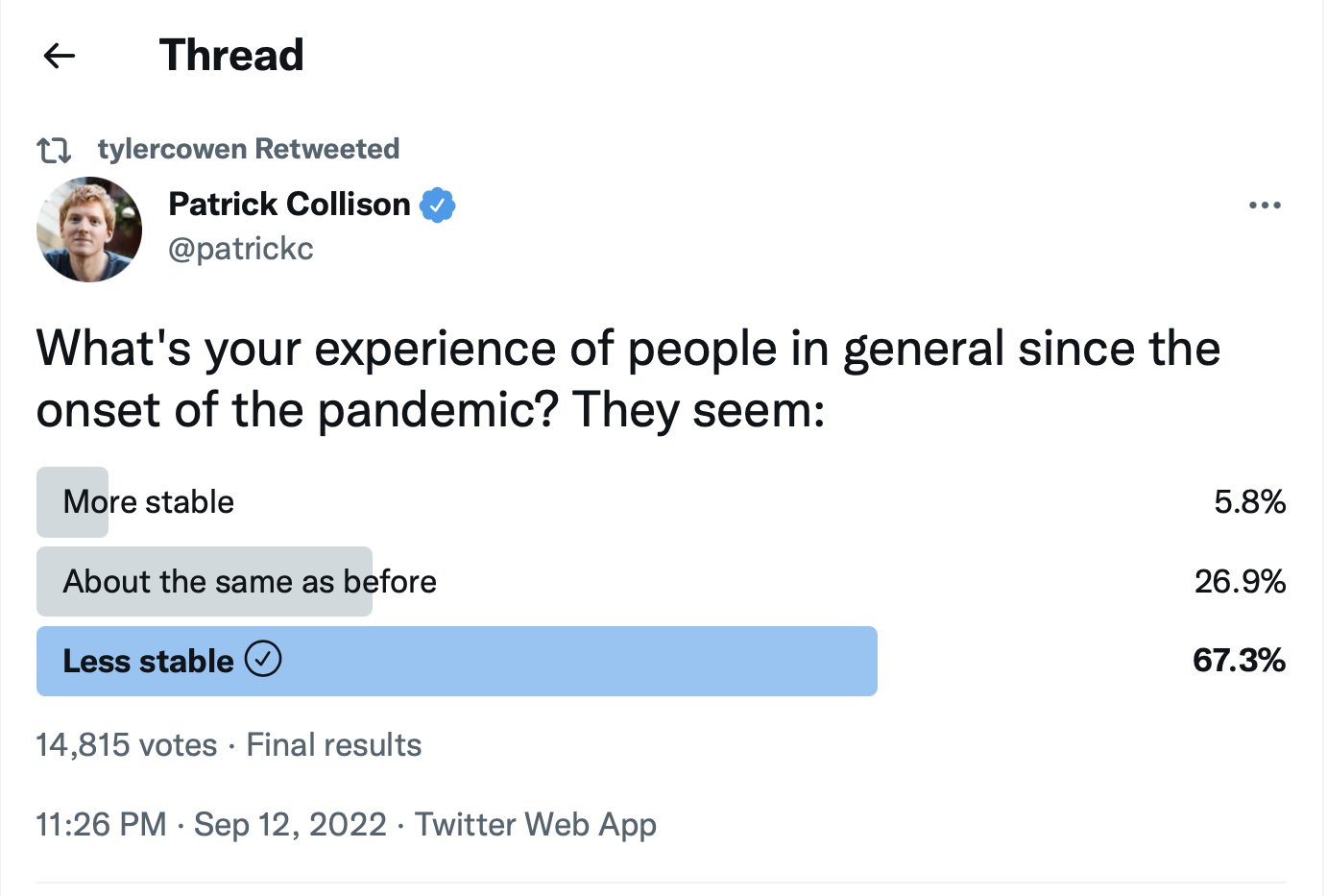
My general vibe thinks Eric’s sense and Patrick’s polls are closer to correct. People do not seem to be back to their previous level of okay. I worry that many people have forgotten what okay would even mean at this point, or are judging their own okay levels relative to others. All of this, of course, is super unscientific.
We are at least, in this one way, all right: New York’s Covid emergency is over, as governor quietly gives up emergency powers.
Monkeypox
Nothing this week. No news is good news.
The War on Cancer Will Continue
Biden announces new ‘cancer moonshot.’
“Beating cancer is something we can do together and that’s why I’m here today.”
Biden likened the effort to Kennedy’s goal of putting a man on the moon in his remarks, which come on the 60th anniversary of Kennedy’s moonshot speech. The goal of the initiative is to reduce the death rate from cancer by 50% over the next 25 years, Biden said.
…
“Under Dr. Wegrzyn’s leadership, ARPA-H will support programs and projects that undertake challenges ranging from the molecular to the societal, with the potential to transform entire areas of medicine and health in order to prevent, detect, and treat some of the most complex diseases such as Alzheimer’s, diabetes, and cancer, providing benefits for all Americans,” the White House said in a statement.
This is the ‘throw government money at problems and things improve’ model. We keep throwing more money at cancer and doing it mostly in incremental ways that have at most small impacts. We may or may not reduce cancer death rates but I would be surprised to see much impact from the announced program – it reads like Do More rather than looking at what would cut the enemy.
Cutting the enemy involves figuring out a new approach, as opposed to the pointer’s suggestions, which were:




That is not a moonshot and this is not an approach to cut cancer risk by half.
There are ways to improve workplace cancer exposure but mostly I would expect attempts to force this to happen to mostly be more red tape that does little.
Attempts to ‘bridge the gap’ will doubtless focus on all the wrong things – in particular, more health care access does not at present much change cancer outcomes.
Diet and exercise are worth working on as an individual for reasons well beyond cancer or Covid. That does not mean we have a path forward for group action, especially when I have no faith that the Official Public Health Advice on those topics will match either the physical reality of people’s bodies or what their minds are prepared to execute in practice. When I see this kind of call, I expect it to mostly involve making people’s lives worse in the hopes they will then make healthier choices.
Alcohol consumption work has been so botched that we have spent a greater amount of effort getting people to consume more alcohol to prevent cancer rather than getting them to consume less. I remember my father drinking red wine he did not enjoy because he was told by Public Health style sources it was preventative. I am not even that confident Zeke here plans to tell people to abstain.
I do strongly agree that we need more people into more clinical trials faster, and that reforms aimed at getting rid of barriers to that would be excellent, and a force multiplier on other efforts. On its own, not thinking big enough.
My guess is that until we fix the completely broken the way we assign research grants and choose which efforts to back, and are able to try things capable of working, throwing more government money at cancer won’t have much effect.
Not Covid
John Oliver is in good form in his latest episode on the Law & Order franchise. I watched it on the elliptical machine in place of my usual watch, which is Law & Order. Law & Order is excellent for this because it maintains a constant stream of events that prevents me from having to focus on being on an elliptical machine, that are exactly the right level of mental engagement when one is also doing maximum effort on an elliptical machine.
Oliver makes many good points. I still can’t help but wonder what would satisfy his complaints, since his core complaint is ‘the police are portrayed in an unfairly positive light and as far more effective than they are’ yet he also complains about the places where cops are portrayed as behaving poorly.
My favorite line is probably “If a medical show were giving us inaccurate information we would say it is dangerous” then compares the situation to Grey’s Anatomy. Whereas I have tried to watch Grey’s Anatomy with my wife who is a doctor and I have some news about the accuracy of its medical information.
I have no idea which section this graph goes under but seems worth noticing.
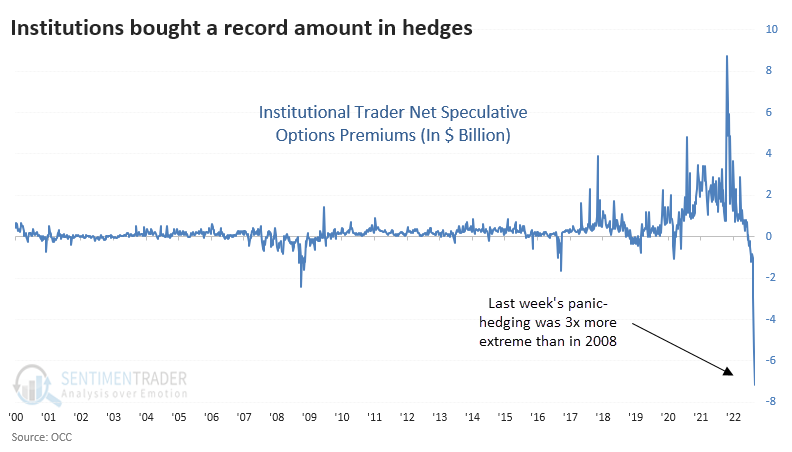
The headline seems misleading given the giant positive spike in ‘21. What is causing these imbalances to suddenly be so big?
The problem of the overproductive employee (OP). Oddly, the problem is not that the employee demands higher compensation. The problem is inability to give them enough to do.
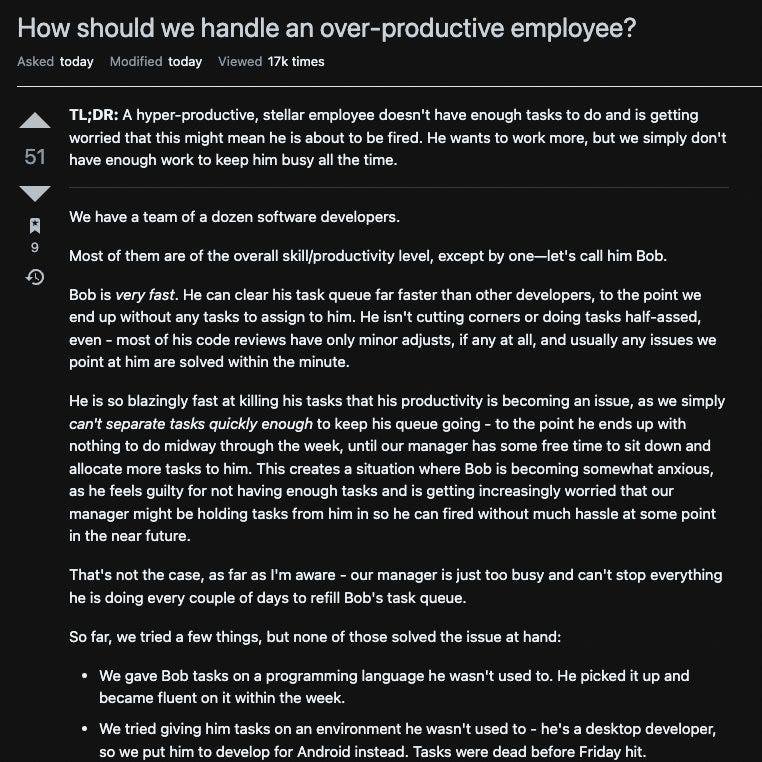
The obvious solution is ‘give Bob more work to do and do it before he runs out of tasks, the manager in question is being an idiot, and also give Bob a raise and make it clear he is not about to be fired.’ There’s a warning that this will burn Bob out, even though Bob wants more tasks. Another good alternative suggested is a long-term side project Bob can always advance. Of course, if you are Bob, there is a much better answer, which is to go somewhere worthy of your talents.
He Admit It
Someone is violating their mask mandate.
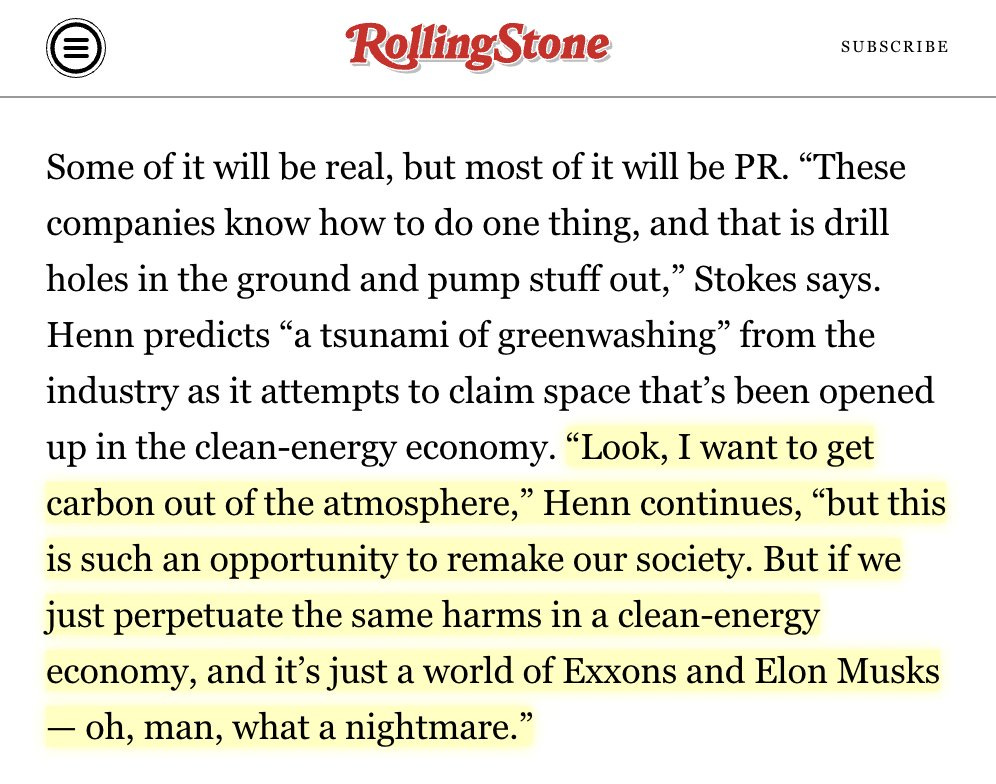

On a related note, New Matt Yglesias and Laura McGann podcast called Bad Takes. First episode is on Climate Justice advocates who opposed the IRA saying it would do ‘more harm than good.’ Key quote: “There is a group of people whose goal is not to reduce carbon emissions. It is to block fossil fuel projects.”
He notices this has little to do with our natural understanding of Climate or Justice.
My current understanding of how groups like this work is that they think this way: What is important is the sacred value of Justice, which means the suffering of bad monkeys. The bad monkeys must be punished and the Sacrifices to the Gods must be made. No amount of good outcomes, no amount of making the world better and people’s lives better, including the very people you claim to be advocating for, can hold a candle to that. Climate here means ‘punish monkeys that are bad on climate.’
Also important to this model: Everyone is a bad monkey.
Very reminiscent of many Covid responses. Seems important to have the goal instead be help the world and the people in it, in this case via reducing carbon emissions.
We need a new term for ‘person who wants to actually reduce the amount of carbon in the atmosphere and actually increase the amount of clean air and water and so on.’
The current word for this means, shall we say, something else.
We also have this very clear explanation of occupational listening requirements.
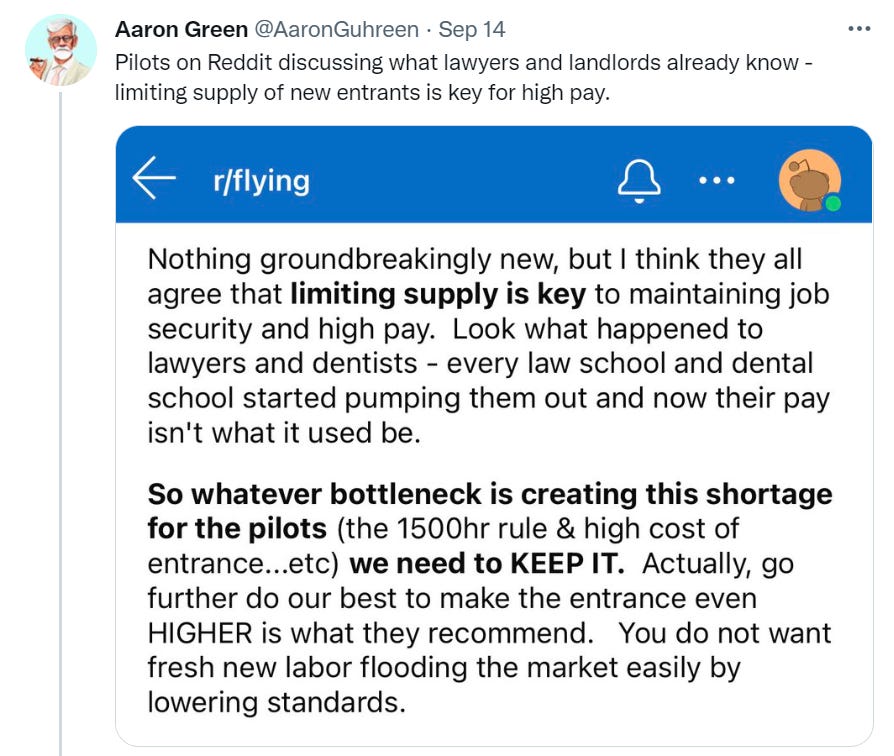
The Impact of Marginal Tax Rates
Paper on the effective tax rate of informal redistribution.
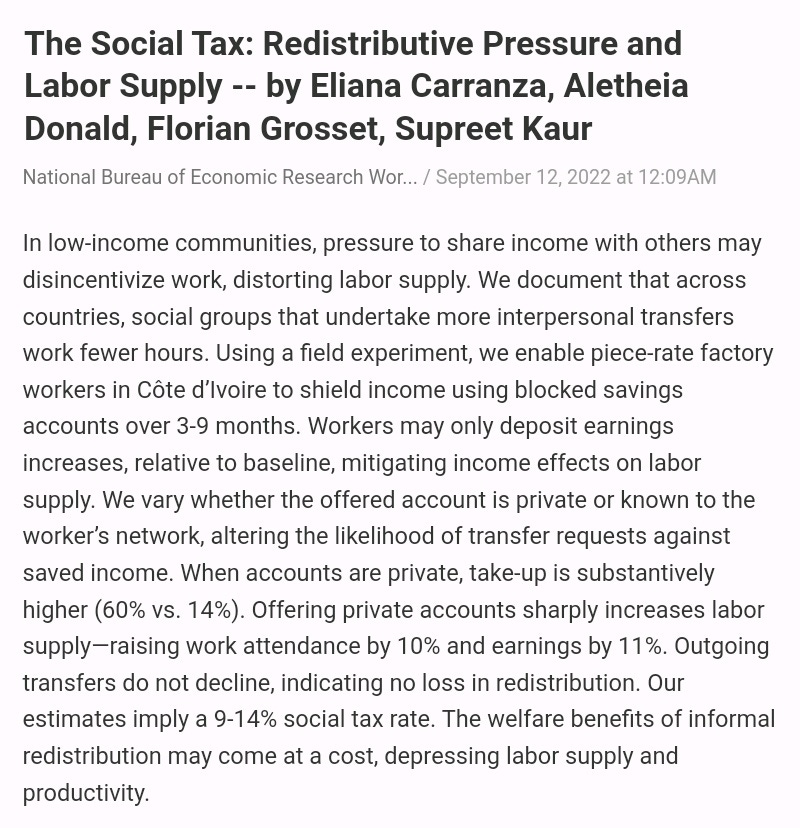
Are these social taxes a huge deal?
It certainly seems like they are.
Offering private accounts that allow workers to (imperfectly, people can still see that you’re working more and may be able to tell if you spend more) shield income increased earnings by 11%, mostly due to 10% increased time spent working – it is also noteworthy that this did not seem to enable anyone to work faster or more efficiently, which is presumably technology-specific. Fully half of people took up these private accounts.
They then calculation that the social tax rate was 9%-14%, which seems reasonably low rather than high. My intuition says these numbers do not make sense together. If I am paying only a 10% marginal tax rate, and you offer to (again, mostly) get rid of that, am I going to increase my hours spent working by 10%? That is a huge effect.
Consider what this implies about optimal tax policy. If an X% tax on the margin decreases all work by X% then the top of the revenue curve is a 50% tax rate even without any tax evasion. Given that these workers could only change hours spent and not other factors, we should expect bigger responses in other contexts. Thus, this implies our current marginal tax rates are too high, well beyond the Laffer curve peak even when only considering local short-term effects. I am skeptical.
Thus, my guess is that the true marginal tax rate is much higher, once one factors in the social costs of tax evasion and all the stress involved, or that the benefits of holding private funds are otherwise being unappreciated somehow.
Bad News
The Queen is dead. Long live the King.
Now that he is the King, he is considered far more likely to be a good King. As far as I can tell, nothing Charles III did was in any way unexpected, so this is a nice clean example of the public not knowing what it thinks.
Polio (!) declared a state disaster in New York.
Cause:

Effect:

I presume I do not need to tell any of my readers to get vaccinated for Polio, if you haven’t taken care of that already. These rates are civilizational-inadequacy-level low.
Also, the CDC is going to be using the term ‘vaccine-derived Poliovirus’ and seriously, what the hell are you thinking, yes I know it is technically right but wow I do not want to hear the CDC talk about boosting public confidence in anything ever again.
If you are on the West Coast, there are entirely non-Covid reasons to be masking up outside, meaning the air quality is quite bad. Seems like a big deal. I wonder how much Covid is causing people to not mask in this spot, versus how much it made others comfortable with an N95.
Halloween candy shortage due to inability to import the necessary sugar used as argument to support our de facto ban on importing sugar. Team Evil loves to troll.
This working means that the combination of the government and telecom companies flat out did not check for duplicate use of the same identity. They had no verification of the social security number, or of the address at which the eligible person lived. A thousand families simply inputted the same name, date of birth and last four digits of her social security number.
Meanwhile, only about 25% of eligible households enrolled, because if you give poor people various different little bits of money guarded by hoops most of them won’t know that the bits of money are even there let alone how to navigate the hoops.
Do lawmakers know that money is fungible? That nothing that is going on here is good for anything when compared to changing the income tax schedule for lower incomes? Unless you want to get households to buy internet connections they do not think are worth the money, because they use cell phones that don’t need the connection and don’t want to hook up smart TVs or computers. Or you want to punish those who don’t have need of a full internet connection for some reason.
Rail workers got close to going on strike, which would blow out our food supply chain with ripple effects from even a short disruption. Post claims Congress would block the strike but might be too slow to act, which raises the question of when a strike would be allowed and thus why Congress hasn’t blocked such strikes in general. The uncertainty did not help negotiations. A minority of unions reached agreement early:
Five unions have reached tentative agreements with railroads on a new contract based on the PEB recommendations, which call for 24 percent raises over five years and back pay but don’t address workers’ concerns about grueling hours and limited time off.
It is interesting to see those unions take compensation in money over conditions. This is still only a 5%/year raise, so given the spike in inflation and lack of other concessions I’m surprised they couldn’t get a better deal. The later deals had similar raises.
Turns out it all worked out for the remaining unions at the last minute (WSJ on the deal, Reuters on the deal), as it often does.
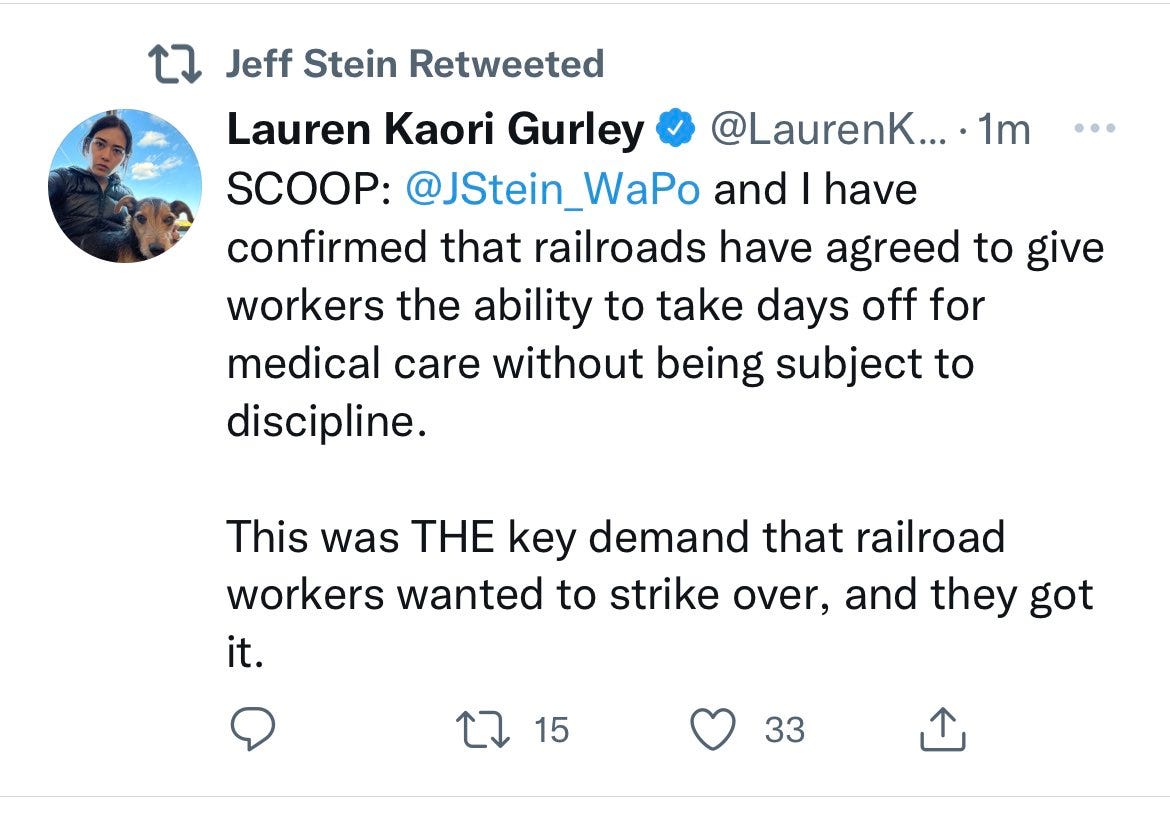
So in contrast to the early settlers, on the margin the bulk of the unions mainly wanted more flexibility for their workers rather than more money. This certainly sounds like a highly reasonable request, and I have never had a job I would have worried would discipline me for taking days off for medical care. Then again, they also never would have worried about me doing this for no good reason without notice, or using it to take as many days off as I could, or citing a union contract to do so. And I always have had coworkers willing to step up when necessary and cover such situations. It is entirely not obvious whether this concession was or wasn’t efficient.
I suppose this is what happens when an industry sheds most of its jobs. Given how valuable it is to keep the railroads running smoothly, my presumption is that it we are not employing enough rail workers. We should, for example, have enough that it isn’t an issue for them to take time off on occasion.
From the comments, an interesting note on suburbia versus safety obsession:
May this collide with “we should only build suburbia because it’s a good place to raise children”. If the front-/backyard and the isolation of being home alone (for an hour — what’s the age required for one day?) are not actually amenities for parents in caring for their children, then maybe the One Correct Urban Form is actually (reaches into hat) terraced small-multifamily?
…
It makes a perverse kind of sense, honestly. If some people move to the suburbs to sate their fears over safety, there’d be a small contingent whose fears persist anyway (sort of like with anxiety and reassurance cycles). Then they’d demand even more safety.
I have never liked suburbia so discount my take accordingly, but this seems rather important. The whole point of suburbia is that it is a safe space, in the literal sense. That is valuable. You can let your kids play in the yard or walk to and hang out at a friends’ house or leave them alone everyone involved feels safe doing so here. Whereas in a city, they would feel unsafe.
(I say ‘feel safe’ because many cities have lower crime rates than suburbia.)
That doesn’t work if they feel almost as unsafe anyway. If buying a suburban house does not give you the ability to leave your children there or in its yard unsupervised, or otherwise not constantly watch them, what purpose the suburban house? You do still get more space, which I did appreciate during the pandemic, but it’s dramatically less effective space than you might think if you can’t reasonably use it. On top of that, all the distances mean you spend a ton of your time shuttling kids around. Seems like a nightmare.
This is the original survey of parents’ attitudes, complete with the median age of 10 before children can play in their own yard while a parent is inside. Madness.
My own followers, as you would expect, did not agree.
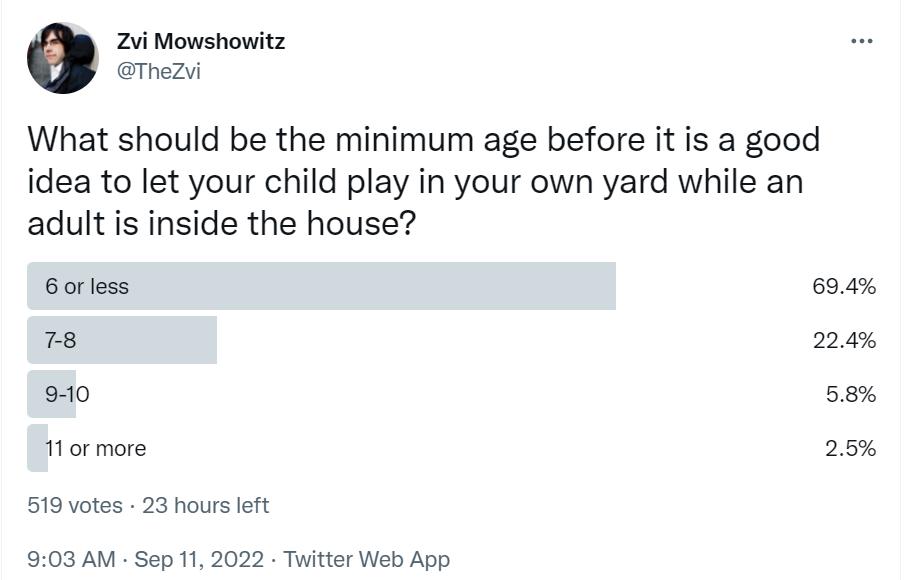
At that point, the poll was retweeted by an account, @FreeRangeKids, dedicated to the noble cause of Free Range Kids, that has double my follower count. I would have expected that to change the distribution, but vote count tripled and yet it didn’t change at all.
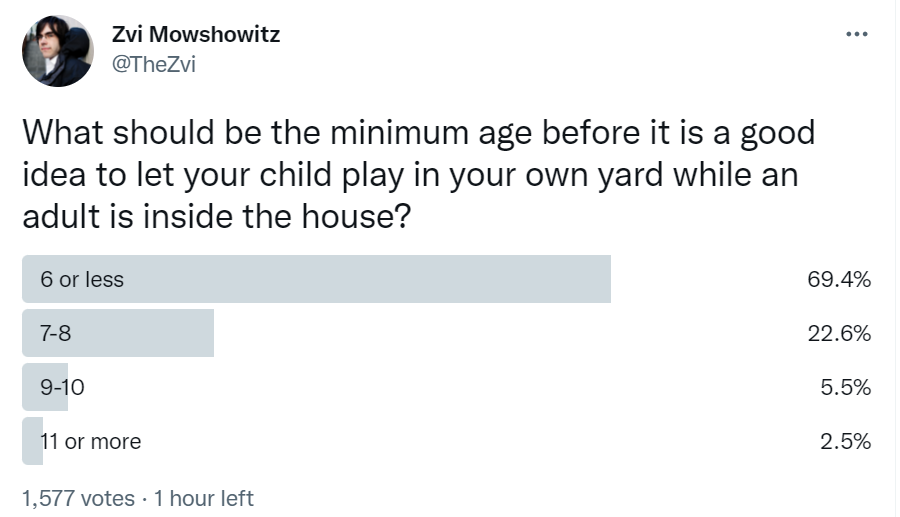
I find this convergence fascinating.
Economics of NASA’s Artemis mission seem quite terrible (Bloomberg). It does seem like private space exploration is great and public space exploration costs orders of magnitude more if you think the goal is ‘explore space’ and not ‘pork-barrel spending.’ Whatever Right Stuff NASA used to have is clearly no longer present.
We need, but will presumably never get, a Vehicle Weight Tax.
Our attempts to thwart the Panini Kid have come to naught.
Ron DeSantis declares that in the Free State of Florida one of the things you will be free from is the construction of multi-family housing. He’s not one to drain the swamp.
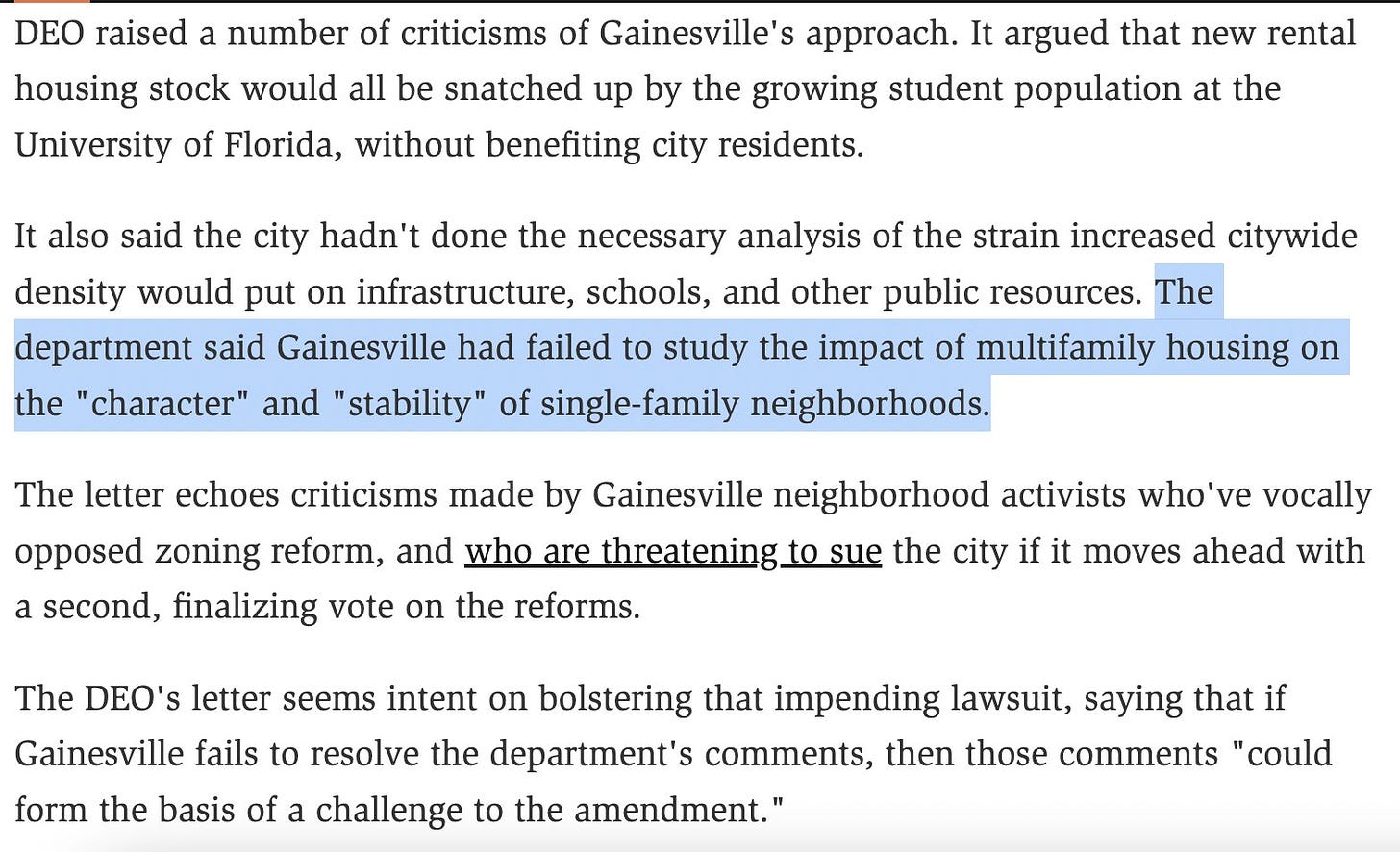
DEO stands for ‘Department of Economic Opportunity.’ They’re against it.
Good News, Everyone
Imposter syndrome is good, actually (says Tyler Cowen at Bloomberg). I am inclined to agree that it is evidence that something good is happening. It would still be better to hold everything else equal and have that person not feel like an imposter. Speaking from personal experience, I can confirm both these principles:
- I have often felt like an imposter.
- This was a sign I was attempting something worth attempting.
- I would have been more effective if I hadn’t felt like an imposter.
- Except when it was important that I knew I was an imposter.
- It helps to know everyone else is mostly an imposter, also.
- Which, again, is good if the alternative is them not attempting as much.
Medical system makes its prices public. Hopes to ward off any attempts to figure out what those prices are on the basis of having 100 TB of incompatible unsorted data formats listing potentially a trillion prices and daring anyone to sort through.
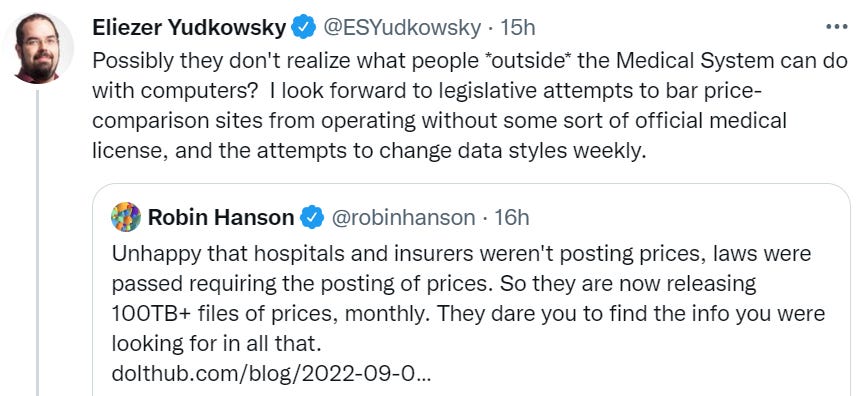
I naively thought that insurers would be publishing the prices they negotiated with the 6,000 hospitals in the US. I was wrong.
A back-of-the-envelope calculation gets me a rough estimate of over 500B different prices, simply from counting how many prices are in each file, multiplying by the number of files. But this is just from the handful of insurers I scraped (and who were in compliance.) All told, the total number of prices could reach over a trillion.
That’s because the data dumps include the negotiated rates with every entity that the insurance companies have contracts with. It’s impossible to say how many there are without going through the “in network” files directly, but a cursory look suggests that there are millions.
Here is a scraper if you want to take a shot.
Creating a bot that helps people cancel Comcast is sometimes not the illegal practice of law in California, if you know and hire a very good lawyer.
The inevitable downside of calling something the Responsible Innovation team.

Pinnacle Sports takes its talents to Canada with an official license. Odds are not as great as they were back in the day. They’re still far better than standard -110 lines and miles better than the disgraceful excuse for offerings you see on American television.
St. Paul abandons rent control due to effects of rent control.
Rent inflation is coming down according to Zillow. Rising measured rent drove the CPI increase this month but those increases are due to renters moving from the old market price to the new market price, increasing average price paid, rather than a new rise in the market price. This means that inflation was higher than we counted before, and is lower now. The worry is the extent to which we selectively notice these kinds of errors, and thus see what we want to see.
The other worry is that the report was rather terrible in other ways as well, which is why the stock market took such a big hit. Still this all has ‘why aren’t you rich’ vibes around it. Why was this all such a surprise? That question seems under-explored.
Meanwhile, here is how a state senator thinks supply and demand work.
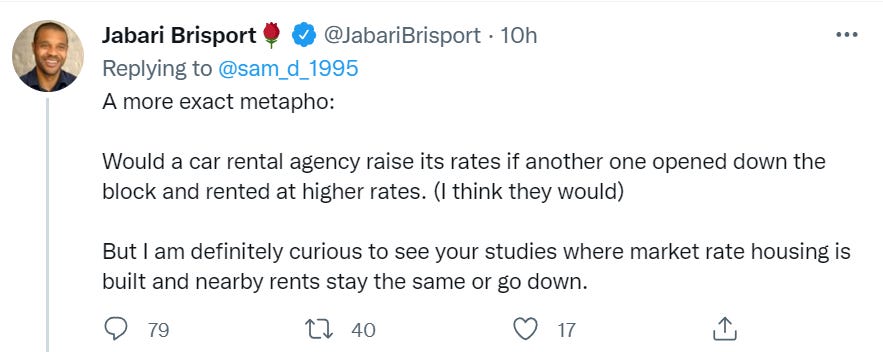
He literally thinks that someone opening a new higher priced car rental agency nearby to an existing one would cause the existing one to raise prices. To be fair, this is not strictly impossible for two reasons.
- The existing rental agency might have been charging rates that were way too low and constantly running out of cars, and not realizing it can raise prices.
- Those running the existing agency might be stupid enough to think this is how prices work.
In the first case, the existing too-low prices were a problem, no one could get rental cars when they needed them. In the second case, the good news is that the market is very good at sorting that kind of mistake out.
Colby-Sawyer College admits its tuition price was fraudulent, cuts it by more than half to look affordable, while claiming almost nothing has effectively changed.
Biden officials considering buying oil at $80 to refill strategic reserve. This seems like the right move versus doing nothing. We could do substantially better, however, by buying oil futures out a number of years. Discounts are substantial.
We could convert existing coal plants, operational or otherwise, into nuclear plants (study), saving 15%-35% and providing a clear contrast between the worst possible power source, coal, and one that is better on every front. None of that, however, has ever been the real problem. The real problem is the NRC. They are under the impression the NRC will make things easy. I have no idea why.
Thread and report on NEPA and the need for permitting reform. While I have many things I would love to change, NEPA has taken over the top spot. What Alec discusses here as solutions are changes on the margin that would mitigate a lot of the damage, while leaving a non-sensical base process in place. If this is indeed a once-in-a-generation opportunity to change things, that does not bode well, yet it would be vastly better than nothing at all.
Klobuchar’s latest attempt to break the internet is for now dead, as Cruz uses his powers of despicability for good. The US Congress was seriously considering requiring tech companies to pay for links. Next up in attempting to break the internet (after California, of course) will therefore be the Biden Administration. They are calling for ‘fundamental reforms to section 230’ and ‘increased child protections.’
Not to worry, Lindsey Graham is back with a new attempt, this time to create a federal agency to demand licenses for social media companies.It is unclear whether this is even the most obnoxious bill he introduced this week.
Senator Marshall suggests a compromise.
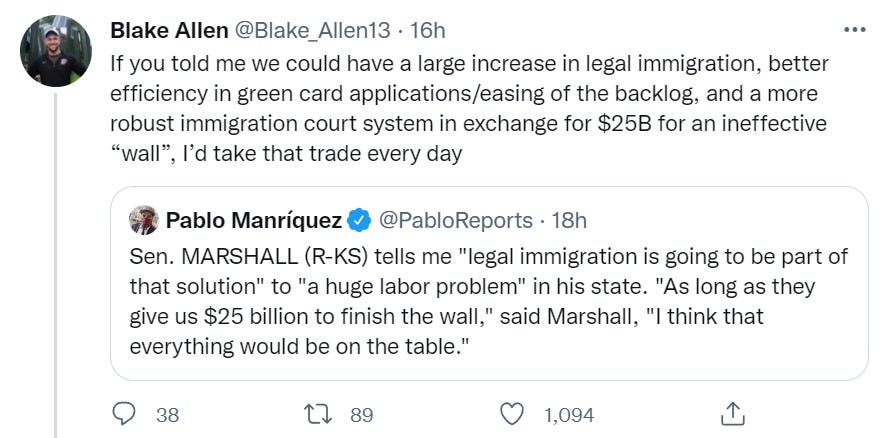
From a piece advocating for more high-skilled immigration, some other potential supporters:
Republicans seem to be interested too. Senator Todd Young said earlier this year that “in terms of skills-based immigration reform, I think it’s essential to maintaining our national competitiveness.“ His comments have been echoed by other members of his caucus such as Senators Cassidy, Cornyn, Braun, and Lankford. Even Senator Chuck Grassley, a longtime immigration skeptic, has said this is an issue on which he has “changed [his] mind completely.”
That’s seven of the required ten, right there.
US to issue all available employment-based green cards. Which raises question of why only the employment-based ones, and also why there are only so many available.
An ongoing theme of incremental proposals is to find ‘cap exemptions,’ where under sufficiently slam-dunk conditions someone’s green card does not count towards the cap. There are a lot of rather slam-dunk conditions out there. From the looks of things, there is also a lot of breathing room for the executive to do things on their own that the Biden Administration is not taking advantage of. If they think it is constitutionally fine to use an ‘emergency’ and an anti-terrorism bill to enact ‘student loan forgiveness,’ expanding the O-1 visa’s definition of ‘extraordinary ability’ well beyond metahumans seems within our grasp.
Twitter polls are not scientific, but the people seem to agree that this qualification is reasonably broad…
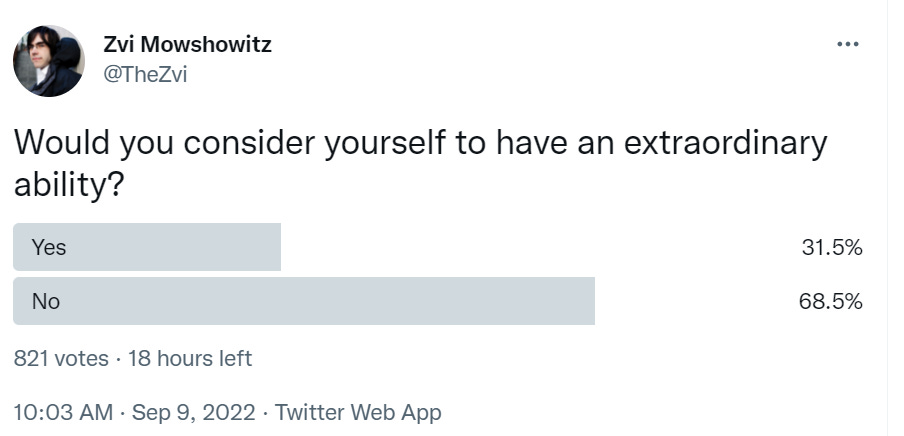
If you’re a founder, you should qualify already, but this can be tricky. Perhaps EB-1? It is touted as ‘the most difficult to get’ and that is doubtless true in general. That is still a great path for those who can get one, if those who qualify can indeed reliably get one.
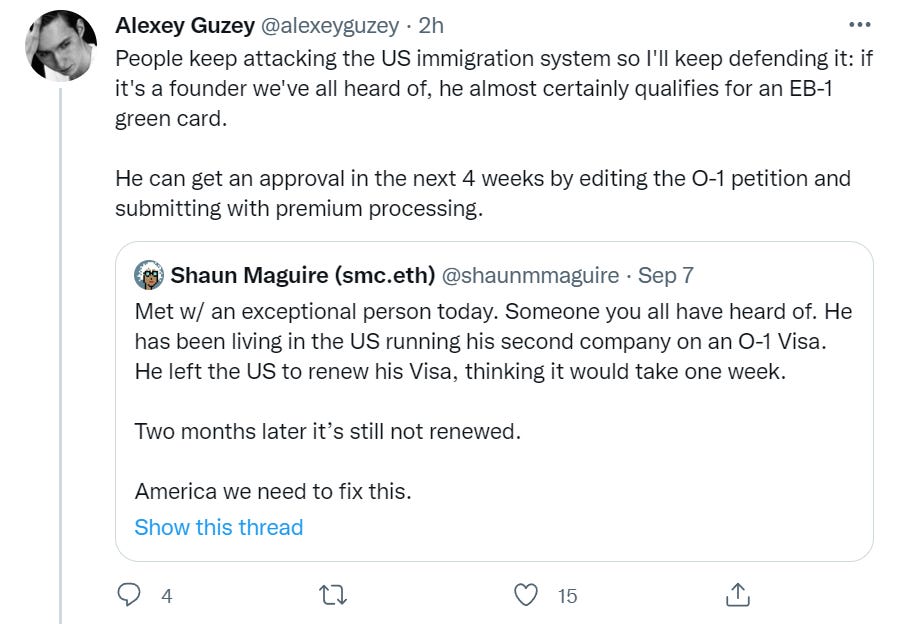
Or one could argue that it (low-skilled) immigration is bad because we want child care to be more expensive.
An argument that dishwashers can actually clean dishes so you mostly don’t have to clean them first. This has not been my experience, which has been more that the dishwasher is the goggles.
A thread of great video game memories of one’s youth. Good times, man. Should perhaps have made much more of an effort to play video games with friends in my pre-Magic era. In the Magic era this naturally ceased to be a problem.

Technology Connections has two videos on dishwashers that go into why they suck for so many people, starting with https://www.youtube.com/watch?v=_rBO8neWw04. TLDR: the pods that most people use can only be released at one point in the cycle, but ideal performance comes from having some detergent in the pre-rinse, which means pouring powder into a second compartment or putting it right in the dishwasher before starting.
It’s also pretty variable by model, though – in a previous apartment I wouldn’t trust anything I hadn’t scrubbed clean myself, now I’m happy to throw in a plate with lots of caked-on food scraps and know it’ll come out clean.
“Covalent” –> “bivalent”, more typically.
Re timing of booster and flu vaccine: Since we’re now just about recovered from COVID-19, we had to think about when to time the bivalent booster, and also the flu vaccine, for our household.
I looked at the CDC guidance, read 2 papers from the literature, and consulted the guidance of YLE. Conclusion: at least 2 months from onset of infection, but no more than 3 months.
COVID-19 for us started at the beginning of August. So we’ll be getting our bivalent booster and our flu vaccine sometime in early October to early November.
re dishwashers – there’s an amazing difference in washing ability between top end bosch/miele and the rest of the crap. Never have to clean anything with those.
“Do lawmakers know that money is fungible? That nothing that is going on here is good for anything when compared to changing the income tax schedule for lower incomes? Unless you want to get households to buy internet connections they do not think are worth the money, because they use cell phones that don’t need the connection and don’t want to hook up smart TVs or computers. Or you want to punish those who don’t have need of a full internet connection for some reason.”
Bro, do you even Democracy?
“The poor defraud new program for $X and their taxes stay the same” has crucial differences to “new program doesn’t exist and taxes on the poor are reduced by $X”:
1. Bureaucrat jobs on the new program.
2. Bureaucrat leadership of the new program gets to point to the gross of the payouts from the new program as a sign of, who knows, call it success. And thereby grow their prestige and power.
“I have never liked suburbia so discount my take accordingly, but this seems rather important. The whole point of suburbia is that it is a safe space, in the literal sense. That is valuable. You can let your kids play in the yard or walk to and hang out at a friends’ house or leave them alone everyone involved feels safe doing so here. Whereas in a city, they would feel unsafe.
(I say ‘feel safe’ because many cities have lower crime rates than suburbia.)
That doesn’t work if they feel almost as unsafe anyway. If buying a suburban house does not give you the ability to leave your children there or in its yard unsupervised, or otherwise not constantly watch them, what purpose the suburban house? You do still get more space, which I did appreciate during the pandemic, but it’s dramatically less effective space than you might think if you can’t reasonably use it. On top of that, all the distances mean you spend a ton of your time shuttling kids around. Seems like a nightmare.”
I don’t have kids and still prefer suburbia to downtowns. Quiet/nobody ever bothers you, clean, low rents, more indoor space for projects and endless musical instruments, easy access to hiking, everywhere you want to go has free parking and usually isn’t too long a drive (low traffic too), roads make sense (the progressive urban design youtubers in my suggested videos hate “stroads” but they’re by far the most useful kind of road) and aren’t mazes of one-way nonsense. The “there’s nothing to do” claim always seems to end up resolving to the urban-praiser’s idea of “something to do” being “spending a lot of of money at bars and restaurants”. We have that as an option too, but… we also have, like, outdoor active things to do. And the house and garage space for way more interesting options.
“low rents”
1) Partly wrong metric. Add in the ~unavoidable monetary costs of transportation (fuel+insurance+maintenance+depreciation vs. a transit pass) and the cost of the commute/errands taking a longer time (if that is the case). If you feel like it, throw on the external costs of the transportation.
2) Standard economist quote of “nobody wants to go there because it’s too crowded”. If many people are evidently willing to pay a premium for options other than suburbia, quite what is the argument for not letting people produce more of it? (Not my main point here, but the “downtown vs. suburbia” dichotomy is unhelpful. Some usual terms are “streetcar suburb” and “missing middle”. Most of the same benefits, for lower costs all around — in construction, in living, even in externalities.)
“One-way nonsense” is exactly the intended mechanism of action? The goal is to create many of the same benefits as suburbia (low noise, fewer/slower cars outside the front door) by making the street an undesirable route for through car traffic.
1. I’m pretty sure public transport commutes are longer on average. In any case my commute is 10 minutes one-way. Fuel is about 800 a year, insurance is about 500 a year, maintenance is about 500 a year, depreciation is negligible since my car is an old Toyota I got for $5k a decade ago.
City dwellers either pay all those costs too (higher probably, especially for insurance) or their quality of life goes way down. Nearby cities and towns have lots of interesting stuff, I don’t want to be limited in traveling to them and see #2.
2. Huh? I didn’t say no more cities should be built. I will note that many people are also willing to pay a premium for avoiding public transport. It is shit. The people are shit and the wait times are shit and the AC is shit and the routes are shit.
3. Well yeah, that’s the kind of antagonism that makes cities so unpleasant. Once you find your destination you still have a puzzle to solve of where you can park, and going past your destination to find parking is risky because you can get sucked onto a one-way street and enough 45-to-90 degree road bends to make it nontrivial to loop around and get back. Then the parking often costs upwards of $10 for just a few hours.
1. My point was exactly that city (or inner-ring suburb) dwellers’ quality of life is high without the necessity to own a car. The obvious historical note is that streetcar suburbs got their name because they were built around streetcar lines.
1&2. Yeah, urbanists assume that public transit can be made to function, at multiple scales (inside cities, in commuterbelts, between cities, including high-speed rail). The standard examples are Switzerland and Japan. Wait times are short, routes are as straight as reasonable given geography, the AC works, the people… well… if you don’t do contraselection, such that a large fraction of those who can afford to not use transit avoid it, so that on the subway you see a representative sample of the entire population (and on intercity buses/trains you see an upward-leaning sample, much as you see on airplanes) then a large part of the problem goes away.
2. Apologies, I was inferring more than you said. (Specifically, that in areas with generally high rents if zoning limits were loosened the existing housing stock would start to be gradually (or suddenly) replaced with higher-density forms.)
3.a Exactly the same is done in suburbia. Streets are laid out in loops or cul-de-sacs to make them useless to through traffic in order to keep them quiet and safe. Superblocks and such are an attempt to retrofit this idea into cities that were laid out with grids, generally before cars became widely affordable. As usual with every idea, there are nutters who present this in the “spite the bad monkey” frame.
3.b For a moment ignore transaction costs, so let’s take an entire lot. For it to be wholly dedicated to parking — either as a flat lot or as a multi-deck garage — the profits from that must be greater than from the most profitable alternative use (be that residential, office, warehouse, etc.). What’s the hourly rate where that breaks even? Furthermore, still ignoring tx costs, arguendo, street-side parking spots should be treated as flat lots (slightly more efficient ones, because they use the street’s travel lane for access to the spots). Which lots could likewise be used for other purposes and thus should have to pay their way.
I have to keep specifying “ignoring transaction costs” because IRL it’s not feasible to slide streets and buildings around in order to group up parking lanes into a block wide enough to build offices on, but this is exactly the idea of equilibrium. Thus, for parking to be cheap and available, one of the following must be the case:
– Land is so cheap in general that no alternative uses outbid parking. (This is the case in rural areas.)
– Land is allocated inefficiently, locked behind tx costs and stupid regulations. (This is the case to an egregious extent in many cities, and not just in the US. Every so often, people in e.g. SF try to create an office-in-a-road-legal-vehicle to arbitrage this land pricing snafu.)
– Choose a mode-chain of transportation with low or zero parking requirements. (Zero for transit and walking, low for bikes and scooters. Supposedly some US commuter rail operators are hilariously stupid, and reason that since there is more demand into the city during rush hour than outward, they should run a larger number of trains inbound than outbound, and thus they store dozens of excess trains downtown. This should not count and they should wear a dunce cap.)
In fact much of the above reasoning applies fully analogously to vehicles in motion if the transportation system is congested. Divide the throughput (rush hour people/hour/direction) of a real or ideal road lane, subway/el route, etc. by their width. (This is why urban train tunnels have been a thing for a century, and car tunnels have not.) Some places where land values are especially high, and car travel on particular roads is already a small fraction of total travel volumes, such as Times Square, have completely taken out car travel lanes for this reason, and found that the new use they put the land to is a much better fit.
Your arguments are tilted towards “how should society arrange its spaces for maximum utility”. That’s a legitimate question but not the one I’m interested in, which is “given society as a constant, is it better to live in a suburban or urban part of a city”.
I’m not sure this is the end of the story with Omicron. Yes, it didn’t evolve naturally in a population of mice. And yes, it wasn’t directly engineered. But the lab hypothesis that I’d always heard was serial passage through already immunized mice. The evidence discussed in the twitter thread is perfectly consistent with evolution in a chronically infected human but there’s also this:
>The molecular spectrum of mutations (i.e., the relative frequency of the 12 types of base substitutions) acquired by the progenitor of Omicron was significantly different from the spectrum for viruses that evolved in human patients but resembled the spectra associated with virus evolution in a mouse cellular environment.
https://www.ncbi.nlm.nih.gov/pmc/articles/PMC8702434/
> I am fully recovered now, except that I lost some progress exercising, especially on the elliptical machine, and am still working to get back to where I was before, which I anticipate will take another week or two.
What do you track on the elliptical? What makes you think you lost progress?
I got COVID in 2020 and lost quite a bit of cardio output, but only subjectively. I was unable to do a hill climb that I could prior to COVID infection for about a month after infection. Some combination of being sedentary + lung infection
> “… some of the most complex diseases such as Alzheimer’s, diabetes, and cancer …”
One of these is not like the other. Type 1 diabetes is an extremely simple disease (“the patient’s pancreas is broken”) with a straightforward cure: make an artificial pancreas from a continuous blood glucose sensor (off-the-shelf tech), a controller (control theory is a century-old field) and an insulin injector (off-the-shelf tech). Guess what the hurdle is. The first article I found right now is https://medicalxpress.com/news/2019-06-hacking-diabetes-people-insulin-alternative.html Being a representative example, the article is very muddled between a continuous monitor by itself (which alerts the patient to inject some insulin as necessary), which is lauded as a “life changer” (I mean, yes, it is a lot better than a timer alerting the patient to take a reading), and a monitor-controller-pump system (“closed loop insulin pump”), which automatically takes care of the entire issue without any human attention.
Of course, type 2 is not so easy.
> Diet and exercise are worth working on as an individual for reasons well beyond cancer or Covid. That does not mean we have a path forward for group action…
Walkability (&bikeability). Translate the Netherlands’ highway/traffic engineering manuals to English, replace the existing American manuals with that. Whenever a street/road/etc. needs to be dug up for utilities work, resurfaced, or is otherwise in a situation of “you demolished the existing street and have to build a new one in the same location anyway” it might as well be rebuilt better. While this policy takes 20-25 years to work fully, its budget-relative-to-counterfactual is very low. Do something similar about land use i.e. zoning.
Pilots: the labor market is in one sense very integrated between first-world countries, and afaik in the EU only 200 hours are required (which is low enough that some large airlines have fully in-house flight schools, and passing through all the various trainings nearly produces this much time anyway). Thus the fact that US regulations are stupid and prospective airline pilots (or someone on their behalf) must front-load a cost of ~$100,000 (order of magnitude) over 3-4 years (~2 in Europe) before they can apply is a big deal but not “absolute”. Incidentally, those ~1300 flight hours that the US requires between the time to complete the trainings and the ability to even apply for a job at an airline are obviously a big subsidy to FAR part 135 operations (charter, air taxi, skydiving, sightseeing, small cargo liner).
Another big part is that due to a combination of regulations and practical factors, pilots’ schedules (especially for long-haul flights) end up extremely different from the 9-5 weekdays office schedule that their presumed friend group mostly has. A good comparison would be the week-on-week-off medical schedule. Furthermore, while the job requires an eyewatering amount of specialized training, it doesn’t require a college degree, and to the extent the profession’s culture praises “traditional flying skills” — a hand-eye-coordination task — it looks surprisingly working-class.
On the other end of the stick, pilot supply is also inelastic downward (if a rebound is expected): regulations effectively prescribe a minimum amount of flying (IIRC 3 landings per 90 days), otherwise some of the paperwork expires and a few days of roughly 1-on-1 training/testing (a check ride, otherwise only required once per 9 months) is required to regain it. This is a low-key concern to long-haul pilots even in good conditions (e.g. a transpacific flight, being 12-20 hours one way, has 3-4 pilots on board (and similarly a double or 1.5 shift of flight attendants), often produces a long (18-36 h) crew layover at the destination, pilots need free days at the home base, etc.). (And no, they can’t just take a puddle-jumper tour in a smaller plane; at any one time, a pilot can only have one type rating i.e. only fly one particular model of plane on the job. The industrial strategy around this issue came up in the 737-max crashes: the infamous MCAS was installed to keep the 737-max legally fungible with the older versions of the 737.)
I have to say I’m shocked you didn’t text yourself for Covid just for the additional information.
Personally, I did a rapid test a few days after feeling a bit under the weather and it was positive. I then proceeded to have one of the more mild colds of my life (pre pandemic I would have 6 per year or so) and recovered quite quickly.
While testing myself changed literal zero about my approach to the illness (I took no medicines and did nothing about it) the test was an interesting data point for me.
I dunno, I just like to always know more if I possibly can, and if the cost isn’t too high. I considered using a free test that wasn’t super uncomfortable to be a reasonable tradeoff for more information.
Ignorance is bliss in this case because of the pressure to report a positive test result to people you’ve seen in the past few days.
Huh. There’s no pressure where I live. Our schools don’t even report positive cases anymore.
I would think that respiratory illness should be the reportable fact, and that whether it’s COVID or not should just be a bit of trivia.
That makes sense.
I guess I just assumed Zvi would want to know just to know. It’s more data and it’s data about yourself which makes it even more interesting, generally.
I don’t think much can be inferred about social tax rates or marginal tax rates from a study of factory workers in black Africa. I don’t have access to the paper, but these people are poor and uneducated. Comparing them to people paying high marginal rates in the U.S. is comparing the (often unconsciously) rich to the truly poor. And quite a few well paid Americans have incomes that are not especially sensitive to their efforts–bureaucrats, both governmental and corporate, are numerous, and many other people have a mandatory minimum of work required, whilst others make their real money only after their first 1,000 hours of work, which is what covers their overhead. Then there is the common, and sometimes sad, phenomenon of people who have nothing better to do with their time than work. Others worry about the taxapocalypse to come. Of the wealthy and affluent people I know, some have options of transforming their income to reduce normal taxable income–but most do not have such options, and seek to maximize normal income. In contrast, I have met low income people who are highly aware of the cutoff marks for various benefits programs, which serve as de facto marginal taxes–often very high ones. In the middle most seem to chase what income they can, having neither the luxury of real money nor the luxury of living in welfare world. The notion that most people react strongly to marginal tax rates seems mostly a libertarian myth, one which I once believed and now doubt.
If I were a full-time conspiracy theorist, I might suspect the deep state was building up DeSantis’ credentials with real Americans in order to eliminate the Orange Bogeyman as a live threat. Perhaps only libertarians and Marxists doubt that character is more important than lucre, which might explain some things about present day America and the composition of its ruling class. For people who think and live outside of those weird materialist idealisms, it’s common sense that single family housing produces better character than multi-family. People living in buildings with an entrance price of seven figures may not quite grasp this point. I will go so far as to claim that exactly which families we share our building with might matter. The communists will reject this point, even as their leaders ensconce themselves in The House of Government, and the libertarians will silently note that your financial value equals your moral value = the poor deserve bad neighbors without even a strip of grass for a border. Among the many other problems with multi-family housing, they seem to attract and breed socialists. The compensation is that dense housing tends not to conduce to much breeding at all.
I’m a little impressed that the Cancer moonshot thing has already found its perfect garbage elite representative in Zeke Emanuel: a midwit hyper-careerist who manifests the depth of thought one remembers from those grimly tedious and depressing after-school specials. He’s notable for opposing longevity and research on longevity. That said, the biomedical field as such has great potential in coming decades. I just read a (Gwern-recommended) essay on this subject called “A Future History of Biomedical Progress” by Adam Green– https://markov.bio/biomedical-progress/. I also recommend it as intelligent, knowledgeable, fairly thorough, and audacious in its research program. It can be read as optimistic or pessimistic.
The idea of siting SMRs alongside old coal plants is a good one. Siting them alongside new and old nuclear plants ought to work as well. However, SMRs can offer increased value by providing heat to nearby industry or residences. And they’re small enough to be located much closer to their clients than a typical coal plant, cutting heat and energy distribution costs. I only wonder about security issues for thousands of highly distributed SMRs.
>My current understanding of how groups like this work is that they think this way: What is important is the sacred value of Justice, which means the suffering of bad monkeys. The bad monkeys must be punished and the Sacrifices to the Gods must be made. No amount of good outcomes, no amount of making the world better and people’s lives better, including the very people you claim to be advocating for, can hold a candle to that. Climate here means ‘punish monkeys that are bad on climate.’
A friend of mine hypothesised a while back that SJ is basically the six-Haidtian-foundation version of hippie liberalism, once it had gotten big enough for long enough for a substantial chunk of a generation to be raised in it. This example is Fairness/Cheating, Loyalty/Betrayal, and Sanctity/Degradation outweighing Care/Harm.
Well, I think the claim being made is that, even when police are portrayed as committing misconduct, it’s portrayed as a positive thing. It’s not portraying the police positively in the sense of “the police are effectively doing the things they’re supposed to and avoiding any misconduct”, but rather in the sense of “the police are effective and any means they use towards that end is a good thing even if illegal”.
Zvi, I hope you’re feeling much better with every day. Did you measure your temperature and SpO2 levels during the infection, and if so, were they different from your baseline? Is high SpO2 (>95% & not more than 3% lower than one’s healthy baseline) enough to conclude that one’s course of covid is mild, makes home remedies sufficient, and does not require further medical attention?
On a separate note: my intuition, informed by some anecdotal data (friends doing unwell) and emerging stats (excess and sudden deaths, etc.), suggests that both (re-)infections – and, to a lesser degree, vaccinations – may take a massive toll on our public health, social development, and well-being in the perspective of next 5-10 years. When we add the major stressors, including the sense of collapse, institutional failure, and massive social distrust/disconnection/hostility, then no wonder people struggle with their everyday functioning.
I’m a relatively young guy (33 yo), so I took two shots in 2021 and decided to decline the booster(s). Being cautious about (re)infections + losing interest in social affairs (while these become objectively less exciting) will probably push me into permanent seclusion mode. “Just go out, accept the risk, and try to act like the world is as friendly as in 2005 or 2014” doesn’t work for me. :(
Re: the second point, 7.5% of US adults currently report long Covid, with 40% of US adults reporting being infected in the past. Even if many complaints were psychosomatic, wouldn’t it still be terrifying?
Resources in the description:
(Why did their gather data on gender identity and sexual orientation, but not on the vaccination status?)
On a related note, +16% excess mortality in Europe…
Interestingly, the excess mortality in Japan has been negative over the last 2 years, probably because they so easily embrace masking. Lots of influenza deaths, for example, simply did not happen.
Here’s a meditation on that fact, on the day the US had officially 1 million dead (scroll down a bit, or search for the 6th appearance of “Japan”).
I recommend following the data here (though it doesn’t distinguish between covid and non-covid excess deaths): https://ourworldindata.org/grapher/excess-mortality-p-scores-average-baseline
Hi Zvi,
Please have a look at this graph:
https://mobile.twitter.com/BenjMurrell/status/1570862185819303937
This is small/early data, but I think there is good reason for concern.
I was about to post that tweet and ask for Zvi’s opinion here as well.
Will be in Thursday’s update, one way or another. Thanks.
The algorithm in your previous post implies that you recommend the new Covid booster to a young, healthy person who, say, caught Omicron in January and haven’t got a booster, but not to someone who got the (old) booster in January but never caught Omicron. Why? I’d expect that an Omicron infection is more protective against another Omicron infection than the old vaccine is.
It is reasonable to consider whether one is known to have caught Omicron, especially recently. I kind of assume most people ended up getting Omicron at some point whether or not they noticed.
Pingback: Covid 9/22/22: The Joe Biden Sings | Don't Worry About the Vase
Pingback: Weekly Links 9/26/22 – Ruet Caelum